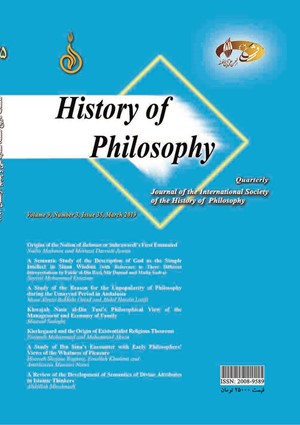-
-
List of Articles
-
Open Access Article
1 - A Study of Ibn Sina’s Encounter with Early Philosophers’ Views of the Whatness of Pleasure
Hoorieh Shojaee Baghini Einollah Khademi Amirhosein Mansori Noori -
Open Access Article
2 - A Study of the Reason for the Unpopularity of Philosophy during the Umayyad Period in Andalusia
Musa Alreza Bakhshi Ostad Abdol Hosein Latifi -
Open Access Article
3 - Khwajah Nasir al-Din Tusi’s Philosophical View of the Management and Economy of Family
Masoud Sadeghi -
Open Access Article
4 - A Semantic Study of the Description of God as the Simple Intellect in Sinan Wisdom (with Reference to Three Different Interpretations by Fakhr al-Din Razi, Mir Damad and Mulla Sadra)
SAYYED MOHAMMAD ENTEZAM -
Open Access Article
5 - A Review of the Development of Semantics of Divine Attributes in Islamic Thinkers
Abdollah Mirahmadi -
Open Access Article
6 - foreword
Hossein Kalbasi Ashtari -
Open Access Article
7 - Origins of the Notion of Bahman or Suhrawardi’s First Emanated
Nadia Maftouni Morteza Darrudi Jawan -
Open Access Article
8 - Kierkegaard and the Origin of Existentialist Religious Theorems
Fatemeh Mohammad Mohammad Akvan
-
The rights to this website are owned by the Raimag Press Management System.
Copyright © 2017-2025







